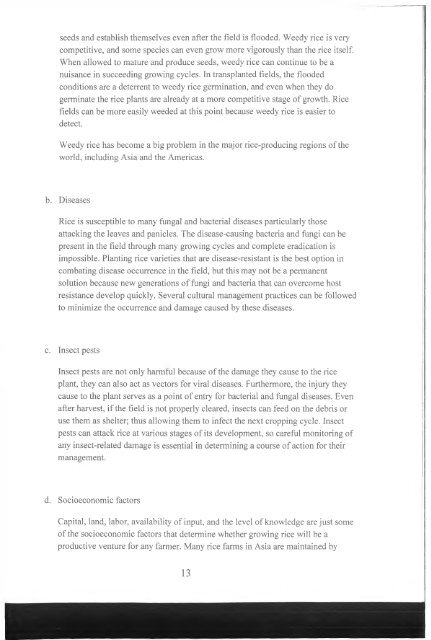Bradbrook - 2012 - Rice Farming complete with methods to increase ric
Bradbrook - 2012 - Rice Farming complete with methods to increase ric
Bradbrook - 2012 - Rice Farming complete with methods to increase ric
Create successful ePaper yourself
Turn your PDF publications into a flip-book with our unique Google optimized e-Paper software.
seeds and establish themselves even after the field is fiooded. Weedy <strong>ric</strong>e is very<br />
competitive, and some species can even grow more vigorously than the <strong>ric</strong>e itself.<br />
When allowed <strong>to</strong> mature and produce seeds, weedy <strong>ric</strong>e can continue <strong>to</strong> be a<br />
nuisance in succeeding growing cycles. In transplanted fields, the fiooded<br />
conditions are a deterrent <strong>to</strong> weedy <strong>ric</strong>e germination, and even when they do<br />
germinate the <strong>ric</strong>e plants are already at a more competitive stage of growth. <strong>Rice</strong><br />
fields can be more easily weeded at this point because weedy <strong>ric</strong>e is easier <strong>to</strong><br />
detect.<br />
Weedy <strong>ric</strong>e has become a big problem in the major <strong>ric</strong>e-producing regions of the<br />
world, including Asia and the Ame<strong>ric</strong>as.<br />
b. Diseases<br />
<strong>Rice</strong> is susceptible <strong>to</strong> many fungal and bacterial diseases particularly those<br />
attacking the leaves and panicles. The disease-causing bacteria and fungi can be<br />
present in the field through many growing cycles and <strong>complete</strong> eradication is<br />
impossible. Planting <strong>ric</strong>e varieties that are disease-resistant is the best option in<br />
combating disease occurrence in the field, but this may not be a permanent<br />
solution because new generations of fungi and bacteria that can overcome host<br />
resistance develop quickly. Several cultural management practices can be followed<br />
<strong>to</strong> minimize the occurrence and damage caused hy these diseases.<br />
c. Insect pests<br />
Insect pests are not only harmful because of the damage they cause <strong>to</strong> the <strong>ric</strong>e<br />
plant, they can also act as vec<strong>to</strong>rs for viral diseases. Furthermore, the injury they<br />
cause <strong>to</strong> the plant serves as a point of entry for bacterial and fungal diseases. Even<br />
after harvest, if the field is not properly cleared, insects can feed on the debris or<br />
use them as shelter; thus allowing them <strong>to</strong> infect the next cropping cycle. Insect<br />
pests can attack <strong>ric</strong>e at various stages of its development, so careful moni<strong>to</strong>ring of<br />
any insect-related damage is essential in determining a course of action for their<br />
management.<br />
d. Socioeconomic fac<strong>to</strong>rs<br />
Capital, land, labor, availability of input, and the level of knowledge are just some<br />
of the socioeconomic fac<strong>to</strong>rs that determine whether growing <strong>ric</strong>e will be a<br />
productive venture for any farmer. Many <strong>ric</strong>e farms in Asia are maintained by<br />
13

















